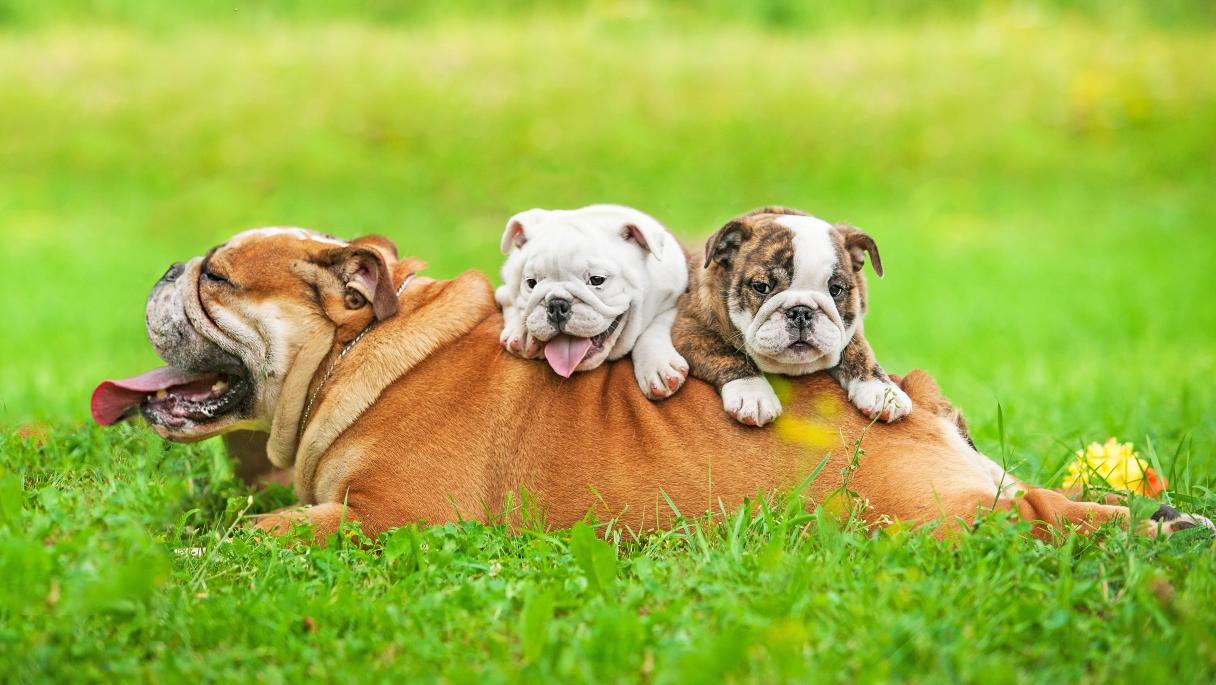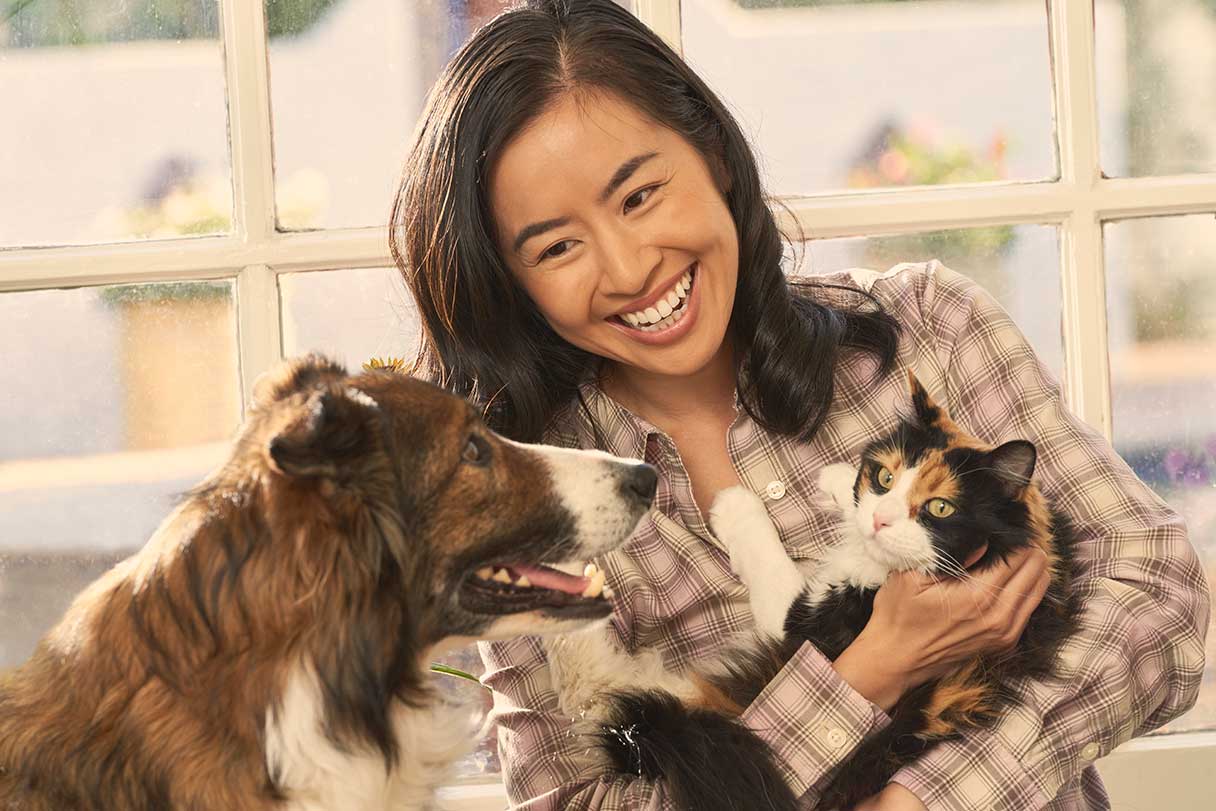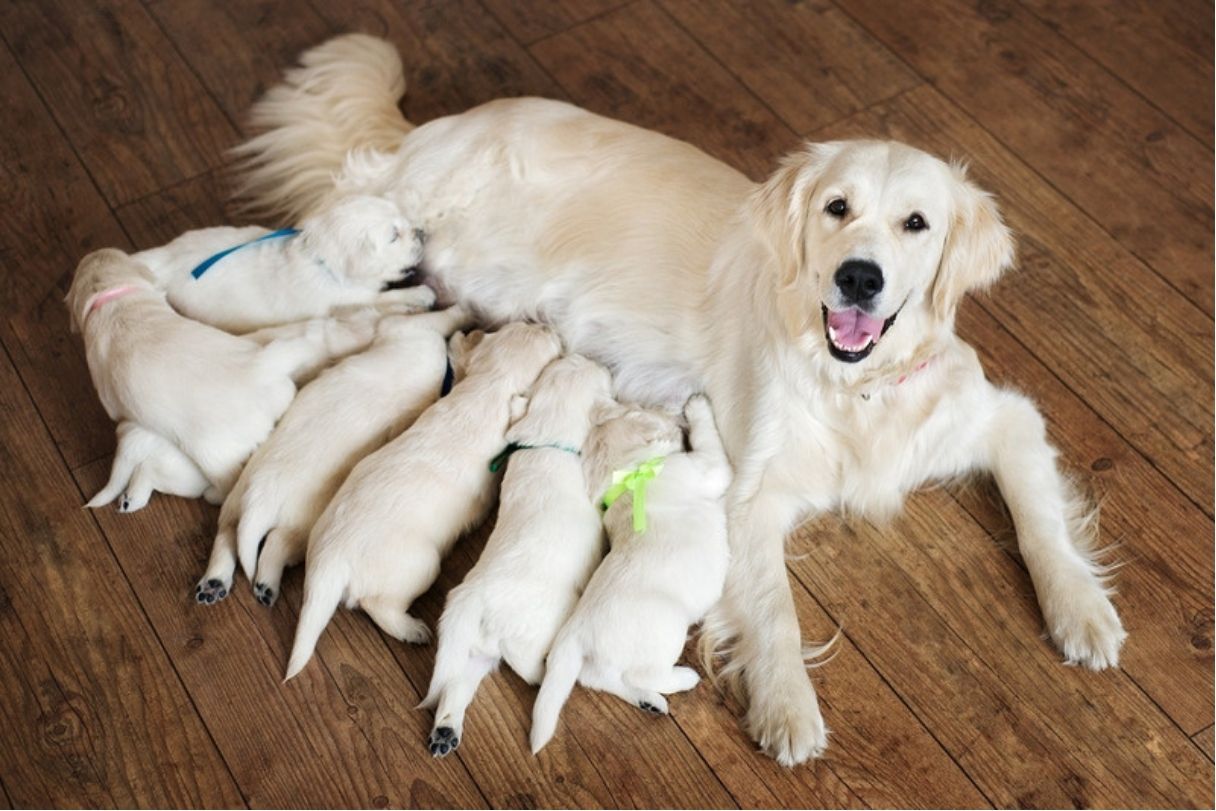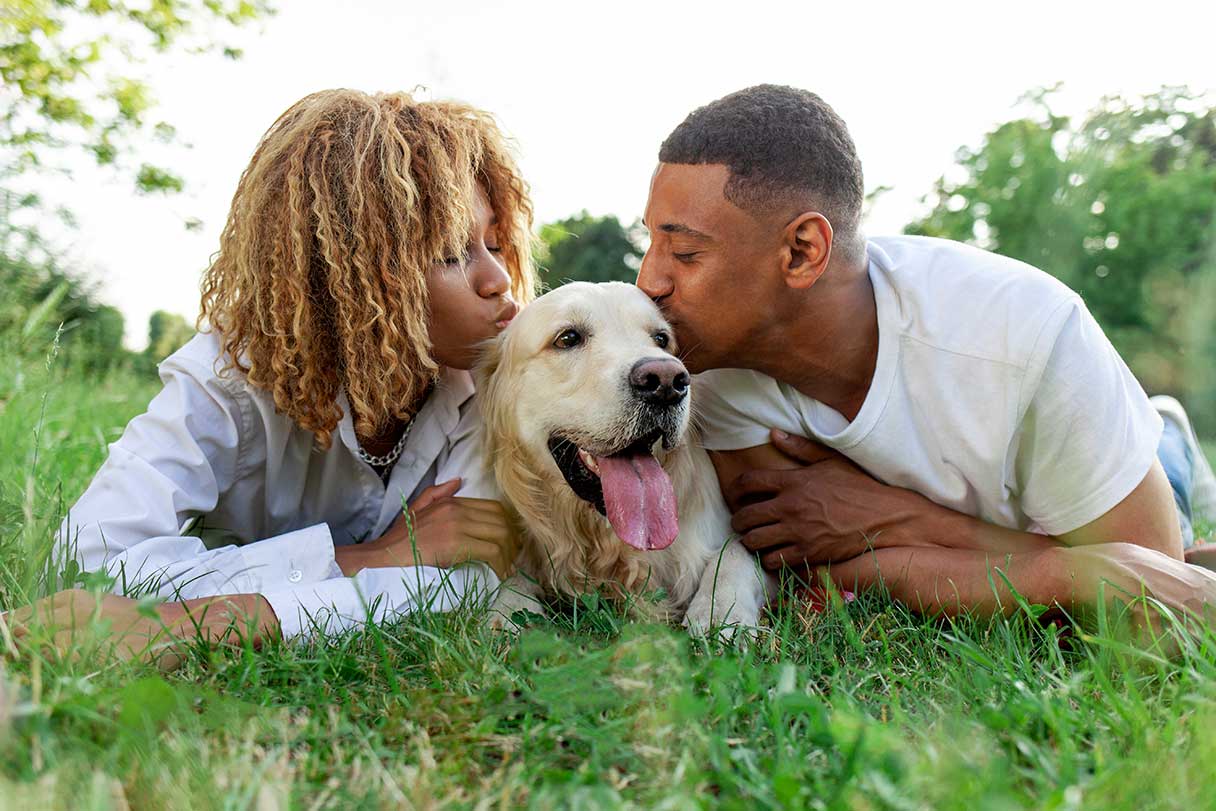If your dog is struggling to give birth or your vet has recommended a planned cesarean section (C-section), you might be feeling a mix of concern and anticipation. How does the procedure work? Is it safe? What will recovery look like for your dog and her newborn puppies?
Understanding the ins and outs of a dog C-section can help you feel more prepared about what’s happening to your pup. Let’s start with the basics.
What Is a C-Section for a Dog?
A C-section is a major surgery in which a veterinarian removes the puppies from the uterus when a dog cannot birth her babies naturally. For some breeds, this procedure may be a safer option to ensure the health of both the mother and her puppies.
It’s usually considered an emergency procedure when there are complications with the natural birth process.
What dogs are candidates for C-sections?
Some dog breeds with large, wide heads and narrow pelvises often require a C-section (in other breeds, this procedure is less frequently required). These breeds include:
- English bulldogs
- French bulldogs
- Mastiffs
- Pekingese
- Saint Bernards
- Boston terriers
- Scottish terriers
- Sealyham terriers
If your dog is one of these breeds or another breed with similar anatomic features, your veterinarian may schedule a C-section in advance, but it’s also a good idea to make plans just in case something goes awry around her due date. Dogs are pregnant for an average of 62 to 64 days.
Other reasons a dog may require a C-section
Dystocia, or difficulty during labor, happens in about 5% of dog births, but some breeds, like terriers and brachycephalic dogs (think bulldogs, pugs and Chihuahuas), face this issue much more often.1 These breeds often have narrower birth canals or large-headed puppies that may complicate things.
If your dog has a small litter of just one to three puppies, the chance of experiencing dystocia can be as high as 59%.2 On the other hand, larger litters with more than eight puppies can lead to exhaustion during delivery. Plus, factors like age and being overweight can increase complications, so it’s important to keep an eye on your dog’s health as she prepares to give birth.
Dog C-Section Cost
The national average cost* of a preplanned dog C-section is $1,229 but can range from $974-$2,226 depending on location, clinic and breed.3 An emergency C-section may cost more. The pricing is reflective of anesthesia, medication and a team of professionals to not only support the mother but also her puppies once they are born.
Many pet insurances offer coverages that include surgical procedures, but sometimes that only extends to emergency C-sections and does not include preexisting conditions (e.g., masses, septa, strictures, anatomic abnormalities, pregnancy at the time coverage was initiated). It’s always a good idea to check your policy or call your pet insurance company to confirm whether C-sections are covered.4
Symptoms Your Dog May Need a C-Section
If your dog exhibits any of the following concerns while giving birth, call your veterinarian immediately, as there may be a complication and she may need a C-section:
- No stage I labor. Stage I is when your dog is restless, panting, digging, nesting or occasionally biting at her sides. Cervical dilation and abdominal contractions are occurring at this stage but may not be visible. Some mothers may go up to 36 hours before stage I labor starts. Consult your veterinarian to determine if your dog should be evaluated.
- Prolonged labor. Your dog has been in stage I of labor (signs noted above) for more than 12 hours, or the second stage of labor (straining and trying to give birth) for more than four hours.
- Pus-like or bloody discharge. All vaginal discharge should be clear, except a white stringy discharge in the days or hours before giving birth. Anything else could indicate a serious infection like pyometra.
- Green or greenish-black discharge. This could indicate that one or more of the fetuses has died. This doesn’t mean that the rest of the litter is going to die, but you should consult your veterinarian.
- Your dog has been in the first stage of labor for more than 12 hours or the second stage of labor for more than four hours. Stage one is when your dog is restless, panting, digging or nesting. Stage two is when your dog is straining and trying to give birth.
- Prolonged labor. Your dog has been in stage I of labor (signs noted above) for more than 12 hours, or the second stage of labor (straining and trying to give birth) for more than four hours.
- Lochia without a neonate (puppy). The presence of lochia (normal discharge from the uterus after a puppy is born; will appear white or red) and no puppy delivered within 30 minutes may indicate placental detachment and should be assessed immediately.
- More than two hours have passed since the last puppy was born. If mom has finished giving birth, the dog will likely start nursing, but if she has puppies left to push out, she will remain restless. If there are two to four hours between births with no straining, it could mean she’s done delivering or experiencing secondary uterine inertia, which occurs when the uterus becomes too fatigued to continue contractions. If you’re unsure, it’s best to have her evaluated by a vet.
- A puppy is in the wrong position. Puppies should come out either head or tail first, with front legs extended forward and back legs extended backward. If the puppy is in a different position, your veterinarian may walk you through manipulating the pup or tell you to take your dog in for a C-section.
There are many criteria for difficult delivery necessitating a C-section. Every dog is different — if you have any concerns, consult your veterinarian.
How Does a Dog C-Section Work?
Once you know your pup is pregnant, your vet will take X-rays closer to her due date to determine the number of puppies and whether any are abnormally large so that you can monitor the situation if need be. If a C-section for your dog is needed, here's what you can expect for the process.
Preparation
If your dog’s C-section is planned, your vet will give you some instructions to prepare, which may include:
- Stop using flea and tick products on your dog one week before
- Stop giving your dog food the night before
- Bathe your dog before the procedure
- Continue to offer your dog fresh water
Be sure to ask your vet about any medications your dog may be taking, as the doctor might recommend withholding them on the day of the surgery.
Procedure
Before starting the procedure, the veterinarian will examine your dog for signs of active labor and may take X-rays or perform an ultrasound before placing an IV catheter, shaving your dog’s abdomen and wrapping her tail to keep it clean.
Once your dog is prepped, she will be sedated and given anesthesia. Once she is fully under anesthesia, an incision will be made through her stomach and uterus.
The puppies will be taken out one by one. For each puppy, the amniotic sack (the membrane encapsulating the little one) will be removed, and the umbilical cord will be cut. After all of the puppies are out, your dog could be spayed at this time to remove the uterus and ovaries and prevent future pregnancies.
Once the procedure is complete, her stomach will be sutured (stitched). The C-section can take one to two hours or longer.
Possible Complications From a Dog C-Section
Your vet will give you instructions to care for your dog and her puppies postsurgery to avoid any complications, but as with any major surgery, there are still potential complications:
- Adverse reaction to anesthesia or medications
- Bleeding or blood clots
- Damage to the uterus (if you don’t spay your dog at the same time)
- Incision scar opening
- Infections
- Injuries to puppies during the procedure
Note: Most veterinarians recommend that a female dog have no more than two to three C-sections in their life and only when the procedure is essential.
Recovery After a Dog C-Section
Your dog should recover from the anesthesia by the time she’s ready to go home but may still be uncoordinated or sleepy for two to 12 hours after the procedure, depending on your dog’s condition, age and how long she was in labor before surgery. Because she could fall or roll over onto them, the puppies should not be left alone with their mother until she is completely awake and interested in nursing. The puppies may also be a bit sleepy and slow to nurse at first due to the anesthesia.
Suggested diet
Offer your dog small amounts of food every 15 to 30 minutes for the first 24 hours after the C-section. She should begin eating within a few hours, but you don’t want her to eat or drink too quickly. While recovering and nursing her puppies, your dog may eat one-and-a-half times her normal amount of food.
Fever monitoring
In the one to three days following delivery, your dog may have a slightly elevated temperature. The normal temperature range for a dog is 100 to 102 degrees Fahrenheit (37.8 to 38.9 degrees Celsius), and if her temperature remains high after three days or goes above 104 degrees Fahrenheit (40 degrees Celsius), contact your veterinarian. Never give your dog aspirin, ibuprofen or any other medication without consulting your veterinarian first.
Bloody discharge
It’s normal for your dog to have a bloody vaginal discharge for the three to seven days after giving birth. Known as lochia, it is often a reddish-brown color but may change over time, starting with a darker red and gradually becoming lighter and more yellowish over time. If it continues longer than seven days, changes color or develops an odor, call your vet. If your dog was spayed at the time of the C-section, she shouldn’t have any discharge.
Removing stitches
Many veterinarians use internal stitches that do not need to be removed. If your dog has visible stitches or staples, they are usually removed in 10 to 14 days. Consult your veterinarian.
More recovery tips
The best thing you can do to keep your pup’s spirits up after the exhausting process of giving birth and having a major surgery is to take good care of her and her babies:
- Check her teats for mastitis or an infection.
- Clip the puppies’ nails so they don’t scratch her.
- Give them a safe, quiet and warm place to rest.
- Keep her clean.
- Monitor her incision and behavior.
- Provide plenty of fresh water.
A C-section can be a lifesaving procedure for both mother and puppies, ensuring a safe delivery when complications arise or when the breed is predisposed to risks. Whether planned or performed in an emergency, proper postsurgical care will help your dog have a smooth recovery. If you have any concerns before or after your dog’s C-section, consult your veterinarian.
CareCredit Credit Card Financing for Dogs
The CareCredit credit card provides a convenient way to pay for your dog's vaccinations and other health and wellness expenses, including exams, medications and products at providers in the CareCredit network.** Continue your wellness journey by downloading the CareCredit Mobile App. You can find a provider on the go, manage your CareCredit account and easily access the Well U blog for more great articles, podcasts and videos. Use our Acceptance Locator to find a veterinarian that accepts CareCredit to help keep your pet healthy and happy for a lifetime of love.
In addition to pet care, you can also use your CareCredit credit card for dentistry, cosmetic, vision, hearing, health systems, dermatology, pharmacy purchases, spa treatments and so much more within the CareCredit network. How will you invest in your health and wellness next?
Expert Reviewer
Dr. Courtney A. Campbell, D.V.M., D.A.C.V.S.-S.A.
Dr. Courtney A. Campbell is a board-certified veterinary surgeon, specializing in orthopedics, soft tissue and minimally invasive surgery. His career extends beyond the operating room; he has emerged as a media personality, infusing his work with an innovative spirit of ‘edutainment’ — a delicate fusion of entertainment and education. Dr. Campbell has shared his expertise on numerous daytime talk shows and news segments, notably as the host of "Pet Talk" on Nat Geo Wild. Today, Dr. Courtney serves as an event host, a conference speaker and a clinical instructor at the Colorado State Translational Institute. He recently founded Stitches Veterinary Surgery, the first surgical specialty hospital in Long Beach, California.
Author Bio
Abbie Mood is a freelance writer with more than 15 years of experience. She has worked with clients of all sizes to create compelling content and she has written for the American Kennel Club, Marriott Bonvoy, Women’s Health Online, Headspace and more.







